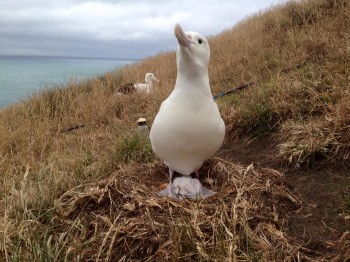ACAP Latest News recently reported on the start of the 2017/2018 breeding season of closely managed Northern Royal Albatrosses Diomedea sanfordi at New Zealand’s Taiaroa Head with 32 nests occupied. At one nest a live-streaming camera (the “Royal Cam”) has been set up for a third year (click here).
The latest news from New Zealand’s Department of Conservation (DOC) is that the colony is having a poor year. In what seems an unusual case, the Royal Cam female attacked its own one-month-old downy chick, which did not then survive. Hatching success has also been lower than average:
“This chick was one of only 16 to hatch this year, as Dunedin’s unusually hot summer has been putting the birds under a great deal of stress. While 29 fertile eggs were laid this year, only just over 50% of these eggs hatched, down from between 70 to 85% in previous years. As well as prolonged high temperatures and the tail end of cyclone Fehi, a lack of wind has been an issue for the nesting birds. Strong winds are vital for the birds to fly and without them albatross are eventually forced to abandon their nests. Weather conditions also increased the incidence of fly-strike after hatching with seven chicks being affected contributing to one mortality. As a result, there has been a high incidence of embryo death inside the egg and the albatross colony currently has only 14 chicks compared with 26 and 23 at the same time over the last two years respectively.”
"DOC rangers are continuing daily management of the remaining chicks to ensure they have the best possible chance of surviving to fledge. Management includes removal of any maggots, supplementary feeding for chicks and nesting birds, and using hand watering and an irrigation sprinkler system on the headland to help keep chicks and adult birds cool."

A Northern Royal Albatross stands over its hatchling at Taiaroa Head
Click here for more information
John Cooper, ACAP Information Officer, 21 February 2018

 English
English  Français
Français  Español
Español